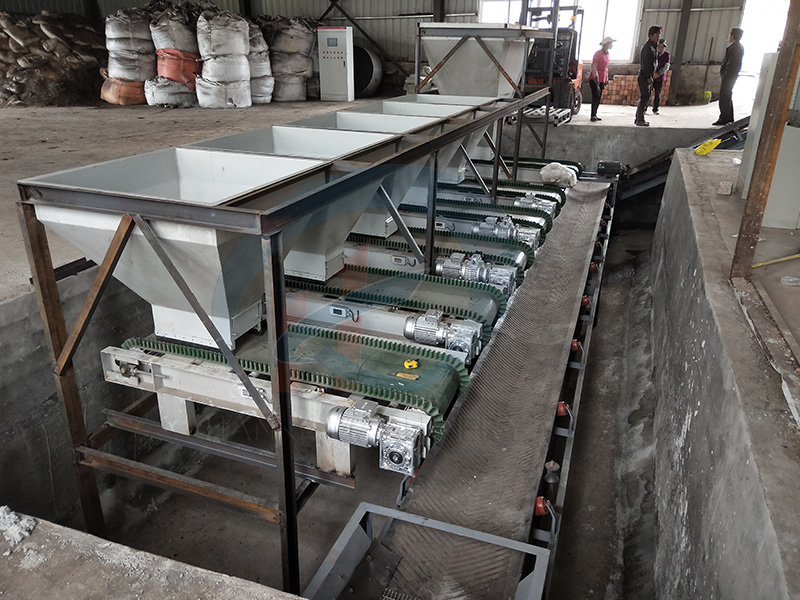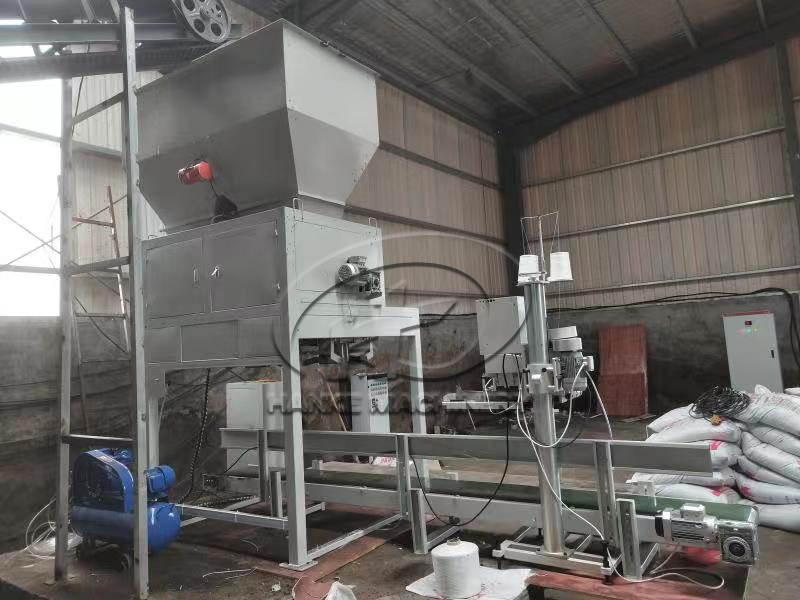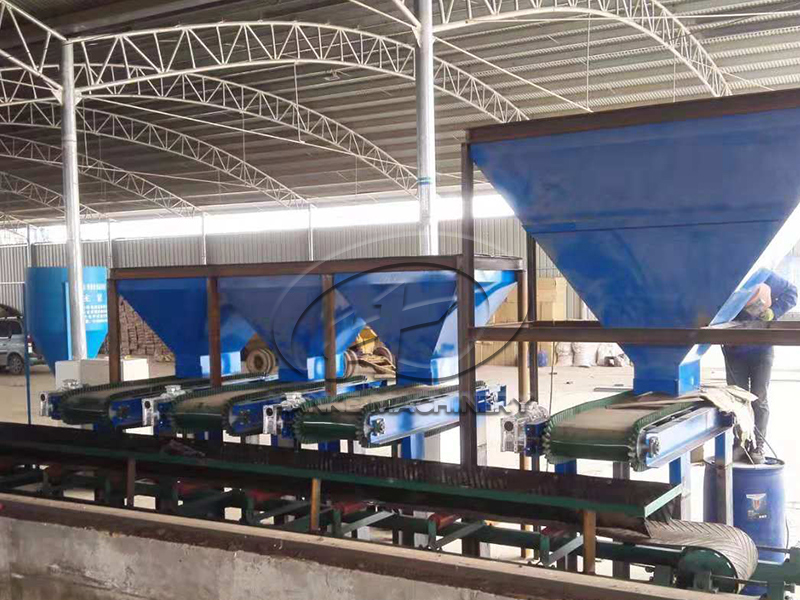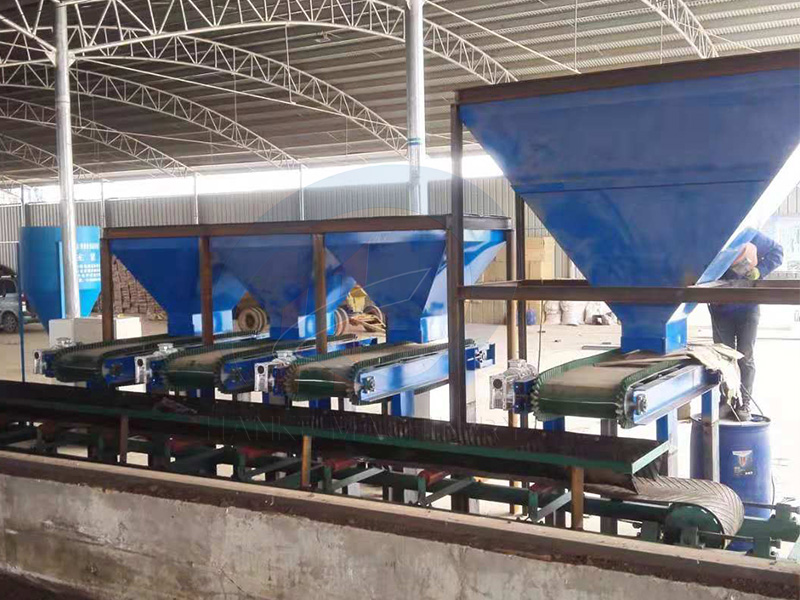 HOME > News > Industry News > How does the NPK compound fertilizer 5-bin main material dynamic batching machine work? How much is
HOME > News > Industry News > How does the NPK compound fertilizer 5-bin main material dynamic batching machine work? How much is Update time : 2025-09-04 Publisher:Zhengzhou Hanke Machinery
The "5-bin Main Material dynamic batching machine" of NPK compound fertilizer is one of the core equipment in the compound fertilizer production line. Zhengzhou Hanke Machinery will provide you with a detailed explanation of its working principle and price range.
I. How does the 5-bin main material dynamic batching machine work?
The core objective of this system is to continuously, accurately and automatically weigh and transport five types of materials, namely the main raw materials such as nitrogen (N), phosphorus (P), potassium (K), and other auxiliary materials, to the next process (usually a mixer or granulator) in accordance with the proportion set by the formula.
The working process of the NPK compound fertilizer 5-bin main material dynamic batching machine can be decomposed into the following core steps:

1. Storage and feeding:
Five independent silos (corresponding to five types of raw materials such as N, P, and K) are installed side by side, and each silo is equipped with a "feeding device" at the bottom.
This feeding device is usually driven by a motor controlled by a frequency converter and can be a screw feeder (the most commonly used), a belt feeder or a vibrating feeder, depending on the characteristics of the material (particle size, fluidity, viscosity, etc.).
The control system regulates the feeding speed by adjusting the frequency of the frequency converter (i.e., the motor speed).
2. Dynamic weighing
Under each feeder, a high-precision electronic load cell (usually a tension sensor or a weighing module) is installed.
This sensor monitors the weight of the material flowing out in real time and transmits the weight signal to the central batching controller (or weighing instrument) at an extremely high frequency (tens to hundreds of times per second).
The meaning of "dynamic" lies precisely here: the system conducts real-time weighing and control during the material flow process, rather than weighing in a static state. This ensures the continuity of production and extremely high efficiency.
3. Intelligent control
The central ingredient controller is the brain of the entire system. The operator pre-sets the "formula" (i.e., the set flow rate, unit: tons per hour) for each material in it.
The controller receives the weight signal from the load cell in real time and calculates the actual flow rate.
It compares the actual flow with the set flow. If the actual flow rate deviates from the set value, the controller will immediately issue an instruction to adjust the frequency converter of the feeder motor to increase or decrease the feeding speed.
This process forms a closed-loop control loop (PID control), constantly making fine adjustments to ensure that the flow rate of each material remains stable near the set value, thereby guaranteeing the absolute accuracy of the ingredient ratio.
4. Mixing and conveying
After the five kinds of materials come out of their respective feeders, they will all fall onto a collection belt conveyor.
During the belt conveyor process, different materials start to be initially mixed and are continuously conveyed to the next process (such as a mixer or directly into a granulator).
What is the price range for a set of the NPK compound fertilizer 5-bin main material dynamic batching machine?
The price range of a complete 5-warehouse main material dynamic batching system is quite wide, mainly depending on configuration, precision, material and production capacity. The following is a rough market reference price range:
The approximate range of the total price is between 50,000 and 500,000 RMB.
Why is there such a big price difference? The following are the key influencing factors:
Production capacity (the most important factor) :
Small-scale systems (with a production capacity of ≤20 tons per hour) : The price is relatively low, approximately 50,000 to 250,000 yuan.
Medium-sized system (with a production capacity of 20 to 50 tons per hour) : The most common configuration, approximately 150,000 to 400,000 yuan.
Large-scale systems (with a production capacity of ≥50 tons per hour) : They have high requirements for equipment rigidity, motor power, and control systems, and the price is over 400,000 yuan.
2. Core Configuration and Brand
Load cells: Imported brands are much more expensive than domestic ones, but they also offer better accuracy and stability.
Frequency converters and electrical components: Using international brands such as Siemens, Schneider, and ABB is more expensive than using ordinary domestic brands, but the system stability and lifespan are longer.
The ingredient controller: Dedicated high-performance ingredient instruments (such as Schenck from Germany and Siemens) are the core, but they are expensive. The cost of a common PLC solution will be lower.
3. Material and anti-corrosion treatment:
Carbon steel material: Standard configuration, lowest price. However, its corrosion resistance is average and maintenance is required for long-term use.
Carbon steel + inner wear-resistant/anti-corrosion layer: Moderate price for highly corrosive materials (such as certain potassium salts).
Stainless steel material (such as 304) : It has excellent anti-corrosion and anti-rust performance, is easy to clean, and meets high standards. The price is 50%-100% higher than that of carbon steel or even more. In the compound fertilizer industry, due to its strong corrosiveness, the use of stainless steel in key components such as silos and feeders has become the mainstream and necessary choice.
4. Degree of automation
Basic type: It only realizes automatic batching control and requires manual inspection and feeding.
Automatic type: It may integrate an automatic arch-breaking device, dust removal system, material level monitoring, and fully automatic interlock control with upstream and downstream equipment, etc. The higher the degree of automation, the more expensive the price.
5. After-sales Service
The price usually includes installation, commissioning, training and technical services. The service network of well-known manufacturers is broader and their response is faster. This part of the value will also be reflected in the initial quotation.
Here are some purchasing suggestions for you
1. Clarify requirements: Determine your hourly output, the physical and chemical properties of raw materials (corrosiveness, fluidity, particle size), and budget range.
2. Contact professional manufacturers: NPK batching equipment is highly specialized. It is essential to seek out manufacturers with mature industry cases. Domestic brands such as Zhengzhou Hanke Machinery all have rich experience in this field.
3. Request for a plan and detailed quotation: Ask the supplier to provide a detailed equipment configuration list, indicating the brand, model, material, production capacity, etc., so that you can make an accurate comparison.
4. On-site inspection and trial operation: If possible, visit the supplier's factory for an inspection and watch the trial operation process of similar materials to verify the batching accuracy and operational stability with your own eyes.
Summary: For a standard medium-capacity (~30 tons per hour) 5-warehouse dynamic batching system made of stainless steel and featuring core components from well-known domestic brands, an initial investment of around 50,000 to 350,000 RMB is a relatively reasonable market price.

see details +

see details +

see details +

see details +

 Tel:+86 17319777703
Tel:+86 17319777703
 E-mail:hkautomaticpack@foxmail.com
E-mail:hkautomaticpack@foxmail.com
 Address:Xingyang City, Zhengzhou City, Henan Province.
Address:Xingyang City, Zhengzhou City, Henan Province.
Privacy Policy Copyright © Zhengzhou Hanke Machinery Equipment Co., Ltd Co., Ltd.